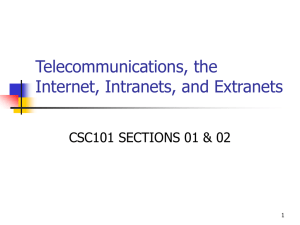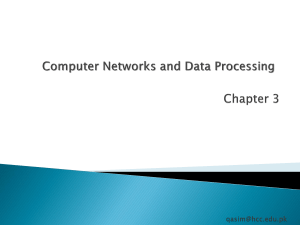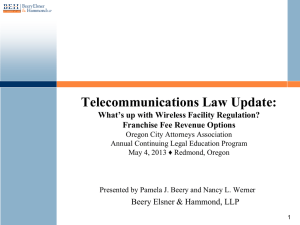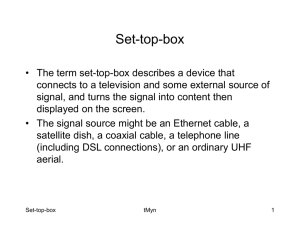Unit 07 - LO2
advertisement
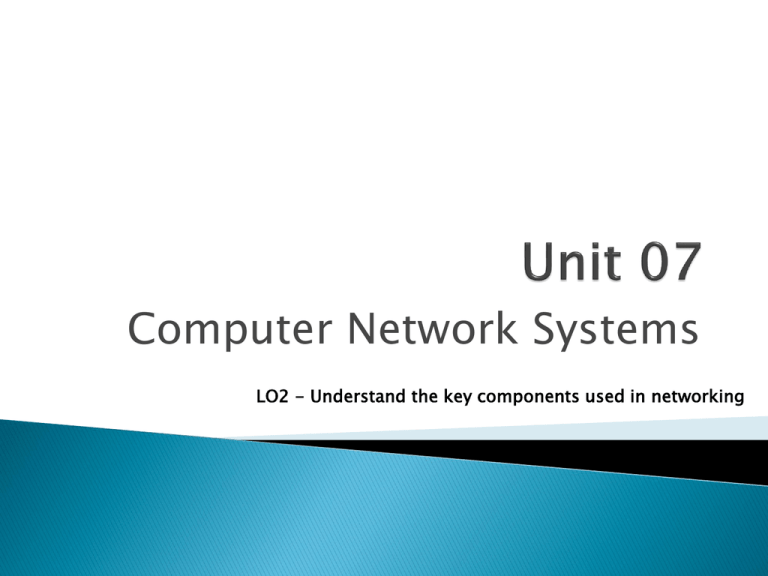
Computer Network Systems LO2 - Understand the key components used in networking You have been employed to explain possible network solutions to the management of a new primary school in the local area with a view to setting up, installing and protecting their networked machines and the information stored on these. The client at the end of the month wants a working network with expansion capabilities allowing up to 200 computers in different computer suites across the building to be connected, the addition of printers and shared resources, a central network pool for information and the capability of adding their media suite of Apples to this network on a restricted access basis. Currently they have two sites, the upper primary and lower primary that are not connected physically. They have100 workstations in the student areas across both sites, 50 base unit computers in the administration and staffing areas, 25 laptops in separate laptop cabinets and 25 Apple G4’s in the media suites. They have 20 shared printers across the two buildings, ten of which are accessible to students with network capabilities including one networkable colour printer in their library in the upper primary building. The school has been given several possible scenarios by their newly assigned network manager needs to know what would be best for the school, the future and how to protect this network from the outside and inside. Longer term they expect to have a working intranet accessible off site where files can be accessed on the network drives by students. P3 explain the key components required for client workstations to connect to a network and access network resources P4 explain the function of interconnection devices M2 design a networked solution to meet a particular situation with specific requirements [IE1, CT1] D1 justify the design and choice of components used in a particular networked solution [IE6] Client computers: The computers that end users use to access the resources of the network. Client computers are typically located on users’ desks. They usually run a desktop version of Windows such as Windows XP Professional, along with application software such as Microsoft Office. Client computers are sometimes referred to as workstations and come in two varieties: Base Workstation – A full sized computer with monitor, keyboard and mouse, hard drive to store the operating system and certain programs like Microsoft Office. They will have their own start up (boot) sequence, operating system and can be used on or off the network. They usually have a Network card to connect to the system but run programs manually to ease the burden on the network. They gain internet access through the servers and print either connected or through the Print Server. The benefit of these is that they can be independent of the network. Thin Client Workstation are similar to Base Units but they do not have hard drives or operating systems. They tend to boot directly off the network through the network card and rely wholly on the network. The benefit of these is that they are all the same, they require little setting up and cannot have software installed. They usually come with no drives except USB as all software is run from the network. P3.1 - Task 1 – Describe the practicalities of Base and Thin client workstations. M2.1 – Task 2 - Outline the relative practicalities and advantages and disadvantages of Thin Client and Workstation networks within a school network. Server computers are the lifeblood of any network. Servers provide the shared resources that network users crave, such as file storage, databases, e-mail, Web services, and so on. Choosing the equipment you use for your network’s servers is one of the key decisions any company with a network make when you set up a network. The hardware components that comprise a typical server computer are similar to the components used in less expensive client computers. However, server computers are usually built from higher grade components than client computers for the reasons given in the preceding section. Motherboard: The motherboard is the computer’s main electronic circuit board to which all the other components of your computer are connected. More than any other component, the motherboard is the computer. All other components attach to the motherboard. CPU), supporting circuitry called the chipset, memory, expansion slots, a standard IDE hard drive controller, and I/O ports for devices such as keyboards, mice, and printers. Some motherboards also include additional built-in features such as a graphic adapter, SCSI disk controller, or a network interface. Processor: The processor, or CPU, is the brain of the computer. Although the processor isn’t the only component that affects overall system performance, it is the one that most people think of first when deciding what type of server to purchase. Intel has four processor models, Two of them — the Pentium 4 and Celeron — should be used only for desktop or notebook computers. Server computers should have an Itanium 2 or a Xeon processor, or a comparable processor from one of Intel’s competitors, such as AMD. Each motherboard is designed to support a particular type of processor. CPUs come in two basic mounting styles: slot or socket. However, you can choose from several types of slots and sockets, so you have to make sure that the motherboard supports the specific slot or socket style used by the CPU. Some server motherboards have two or more slots or sockets to hold two or more CPUs. Memory: Never scrimp on memory. People rarely complain about servers having too much memory. Many different types of memory are available, so you have to pick the right type of memory to match the memory supported by your motherboard. The total memory capacity of the server depends on the motherboard. Most new servers can support at least 12GB of memory, and some can handle up to 32GB. Hard drives: Most desktop computers use inexpensive hard drives called IDE drives (sometimes also called ATA). These drives are adequate for individual users, but because performance is more important for servers, another type of drive known as SCSI is usually used instead. For the best performance, use the SCSI drives along with a high performance SCSI controller card. Network connection: The network connection is one of the most important parts of any server. Many servers have network adapters built into the motherboard. If your server isn’t equipped as such, you’ll need to add a separate network adapter card.. Power supply: Because a server usually has more devices than a typical desktop computer, it requires a larger power supply (300 watts is typical). If the server houses a large number of hard drives, it may require an even larger power supply. But more importantly a backup power supply is necessary, when the server powers off, every computer connected will lose connection so a UPS is necessary, several is better, one for each server. P3.1 – Task 3 – Describe what a Network Server is and outline the hardware specifications of a network server for your client. Print servers Sharing printers is one of the main reasons that many small networks exist. Although it isn’t necessary, a server computer can be dedicated for use as a print server, whose sole purpose is to collect information being sent to a shared printer by client computers and print it in an orderly fashion. A single computer may double as both a file server and a print server, but performance is better if you use separate print and file server computers. With inexpensive ink-jet printers running about £50 each, just giving each user his or her own printer is tempting. However, you get what you pay for. Instead of buying £50 printers for 15 users, you may be better off buying one £1,000 laser printer and sharing it. The £1,000 laser printer will be much faster, will be cheaper to operate. Mail Server A mail server is a server that handles the network’s e-mail needs. It is configured with e-mail server software, such as Microsoft Exchange Server. Exchange Server is designed to work with Microsoft Outlook, the e-mail client software that comes with Microsoft Office. Most mail servers actually do much more than just send and receive electronic mail. For example, here are some of the features that Exchange Server offers beyond simple e-mail: ◦ Collaboration features that simplify the management of collaborative projects. ◦ Audio and video conferencing. ◦ Chat rooms and instant messaging (IM) services. ◦ Microsoft Exchange Forms Designer, which lets you develop customized forms for applications, such as vacation requests or purchase orders. File servers File servers provide centralized disk storage that can be conveniently shared by client computers on the network. The most common task of a file server is to store shared files and programs. For example, the members of a small workgroup can use disk space on a file server to store their Microsoft Office documents. File servers must ensure that two users don’t try to update the same file at the same time. The file servers do this by locking a file while a user updates the file so that other users can’t access the file until the first user finishes. For document files (for example, word-processing or spreadsheet files), the whole file is locked. For database files, the lock can be applied just to the portion of the file that contains the record or records being updated. Web Server A Web server is a server computer that runs software that enables the computer to host an Internet or Intranet Web site. The two most popular Web server programs are Microsoft’s IIS (Internet Information Services) and Apache, an opensource Web server managed by the Apache Software Foundation. Proxy Server Simply put, a proxy server is a server that sits between a client computer and a real server. The proxy server intercepts packets that are intended for the real server and processes them. The proxy server can examine the packet and decide to pass it on to the real server, or it can reject the packet. Or the proxy server may be able to respond to the packet itself, without involving the real server at all. Web servers These often store copies of commonly used Web pages in a local cache. When a user requests a Web page from a remote Web server, the proxy server intercepts the request and checks to see whether it already has a copy of the page in its cache. If so, the Web proxy returns the page directly to the user. If not, the proxy passes the request on to the real server. P3.1 – Task 4 – Describe the functions and use of different Servers. M2.2 – Task 5 - State your clients Server needs and what your client might consider using these for, including the advantages of doing so. Leased line Refers to a phone, ISDN, xDSL, frame relay, or other line that is rented for exclusive, 24 hours a day, 7 days a week use. A leased line connects two locations for private voice and/or data telecommunication service. Not a dedicated cable, a leased line is actually a reserved circuit between two points. Leased lines can span short or long distances. They maintain a single open circuit at all times, as opposed to traditional telephone services that reuse the same lines for many different conversations through a process called "switching." Leased lines most commonly are rented by businesses to connect branch offices, because these lines guarantee bandwidth for network traffic. So-called T1 leased lines are common and offer the same data rate as symmetric DSL (1.544 Mbps). Individuals can theoretically also rent leased lines for high-speed Internet access, but their high cost (often more than £700 per month) deters most. Fractional T1 lines, starting at 128 Kbps, reduce this cost somewhat and can be found in some Universities and Hotels. Dedicated line A dedicated line, such as a T1, is a special high-speed, or hard-wired, connection that is permanent. Any of these connections is always active, always ready. You can be working in your word processing program and hear the “you’ve got mail” sound at any time, because when mail is received at your ISP’s e-mail server, it is sent directly to you over your permanent connection. P3.2 – Task 6 - State what a Leased and Dedicated line means and the advantages and disadvantages to your Client on these Internet Connections. Coaxial Cable - You can construct an Ethernet network by using one of two different types of cable: coaxial cable, which resembles TV cable, or twisted-pair cable, which looks like phone cable. Twisted-pair cable is sometimes called UTP, or 10BaseT cable. This type of cable that was once popular for Ethernet networks is coaxial cable, sometimes called thinnet or BNC cable because of the type of connectors used on each end of the cable. Thinnet cable operates only at 10Mbps and is rarely used for new networks. However, you’ll find plenty of existing thinnet networks still being used. You may encounter other types of cable in an existing network: thick yellow cable that used to be the only type of cable used for Ethernet, fibre-optic cables that span long distances at high speeds, or thick twisted-pair bundles that carry multiple sets of twisted-pair cable between wiring closets in a large building. For all but the largest networks, the choice is between coaxial cable and twisted-pair cable. Twisted-pair cable - The most popular type of cable today is twisted-pair cable, or UTP (Unshielded Twisted Pair). UTP cable is even cheaper than thin coaxial cable, and best of all, many modern buildings are already wired with twisted-pair cable because this type of wiring is often used with modern phone systems. BNC connectors You attach thinnet to the network interface card by using a goofy twist on connector called a BNC connector. You can purchase preassembled cables with BNC connectors already attached in lengths of 25 or 50 feet, or you can buy bulk cable on a big spool and attach the connectors yourself by using a special tool called a crimper. With coaxial cables, you connect your computers point-to-point in a bus topology. At each computer, a T connector is used to connect two cables to the network interface card. A special plug called a terminator is required at each end of a series of thinnet cables. The terminator prevents data from hitting a dead end and returns the information back down the line. The cables strung end-to-end from one terminator to the other are collectively called a segment. The maximum length of a thinnet segment is about 200 meters (actually, 185 meters). You can connect as many as 30 computers on one segment. To span a distance greater than 185 metres or to connect more than 30 computers, you must use two or more segments with a device called a repeater to connect each segment. RJ45 Connectors UTP cable connectors look like modular phone connectors but are a bit larger. UTP connectors are officially called RJ-45 connectors. Like thinnet cable, UTP cable is also sold in prefabricated lengths. However, RJ-45 connectors are much easier to attach to bulk UTP cable than BNC cables are to attach to bulk coaxial cable. They simply plug into the network card like a telephone plugs into the wall. The maximum allowable cable length between the hub and the computer is 100 metres (about 328 feet) All computers now come with an RJ45 connector socket because this is becoming the standard method of base unit connectivity. P3.2 – Task 7 – Describe Coaxial and Twisted Pair cables and the associated connectors and state the preferred method and limitations of use within your client’s classroom environment. STP – Shielded Twisted pair In environments that have a lot of electrical interference, such as factories, you may want to use shielded twisted-pair cable, also known as STP. Because STP can be as much as three times more expensive than regular UTP, you won’t want to use STP unless you have to. With a little care, UTP can withstand the amount of electrical interference found in a normal office environment. Most STP cable is shielded by a layer of Aluminium foil. For buildings with unusually high amounts of electrical interference, you can use more expensive braided copper shielding for even more protection. Category 5 (Cat5) Category 5 or Cat 5 is a standard measure for cabling, Cat1 for Voice to Cat6 for 1000Mbps. Cat5 is the standard 100MBps cabling required for modern networking. If you’re installing cable for a Fast Ethernet system, you should be extra careful to follow the rules of Category-5 cabling. That means, among other things, making sure that you use Category-5 components throughout. The cable and all the connectors must be up to Category-5 specs. When you attach the connectors, don’t untwist more than 1⁄2 inch of cable. And don’t try to stretch the cable runs beyond the 100-meter maximum. UTP (Unshielded twisted Pairs) Unshielded twisted-pair cable (also known as UTP) became popular in the 1990s because it’s easier to install, lighter, more reliable, and offers more flexibility in how networks are designed. 10BaseT networks use a star topology with hubs at the centre of each star. Although the maximum length of 10BaseT cable is only 100 meters, hubs can be chained together to extend networks well beyond the 100-meter limit. 10BaseT cable has four pairs of wires that are twisted together throughout the entire span of the cable. However, 10BaseT uses only two of these wire pairs, so the unused pairs are spares. UTP cable is even cheaper than thin coaxial cable, and best of all, many modern buildings are already wired with twisted-pair cable because this type of wiring is often used with modern phone systems. Fibre optic Fibre Optic is called 10BaseFX. Because fibre-optic cable is expensive and tricky to install, it isn’t used much for individual computers in a network. However, it’s commonly used as a network backbone. For example, a fibre backbone is often used to connect individual workgroup hubs to routers and servers. Fibre-optic networks also require NICs. Fibre-optic NICs are still too expensive for desktop use in most networks. Instead, they’re used for high-speed backbones. If a server connects to a highspeed fibre backbone, it will need a fibre-optic NIC that matches the fibre-optic cable being used. Wireless mobile technology A wireless network is a network that uses radio signals rather than direct cable connections to exchange information. A computer with a wireless network connection is like a mobile phone. Just as you don’t have to be connected to a phone line to use a mobile phone, you don’t have to be connected to a network cable to use a wireless networked computer. A wireless network is often referred to as a WLAN, for wireless local area network. The term Wi-Fi is often used to describe wireless networks, although it technically refers to just one form of wireless networks: the 802.11b standard. A wireless network has a name, known as a SSID. SSID stands for service set identifier. Each of the computers that belong to a single wireless network must have the same SSID. Wireless networks can transmit over any of several channels. In order for computers to talk to each other, they must be configured to transmit on the same channel. The simplest type of wireless network consists of two or more computers with wireless network adapters. This type of network is called an ad-hoc mode network. A more complex type of network is an infrastructure mode network. All this really means is that a group of wireless computers can be connected not only to each other, but also to an existing cabled network via a device called a wireless access point, or WAP (Hotspot). P3.2 - Task 8 – Describe the different kinds of Connections and Cabling within a Network Environment. M2.2 – Task 9 - State how your Client can or should use these cabling methods within their network set up. Coaxial Twisted Pair BNC RJ45 Cat-5e and 6 UPT Fibre Optic Wireless All network operating systems, from the simplest to the most complex, must provide certain core functions, such as the ability to connect to other computers on the network, share files and other resources, provide for security, etc. For this there has always been two direct rivals Novell and Microsoft. Windows NT Server was the last in a long series of Windows servers dubbed NT, which stood for New Technology. The “new technology” that got everyone so excited about Windows NT in the first place was 32-bit processing, a huge step up from the 16-bit processing of earlier versions of Windows. Windows NT was the first Microsoft operating system that was reliable enough to work as a network server on large networks. Version 4.0 shipped in July 1996, so it is now more than nine years old. That’s a lifetime in operating system years (which are kind of like dog years). Probably the most important feature of Windows NT is its directory model, which is based on the concept of domains. A domain is a group of computers that are managed by a single directory database. To access shared resources within a domain, you must have a valid user account within the domain and be granted rights to access the resources. The domain system uses 15-character NetBIOS names to access individual computers within a domain and to name the domain itself. Although Windows Server 2003 is newer, Windows 2000 Server is currently the most popular server operating system from Microsoft. Windows 2000 Server built on the strengths of Windows NT Server 4 by adding new features that made Windows 2000 Server faster, easier to manage, more reliable, and easier to use for large and small networks alike. The most significant new feature offered by Windows 2000 Server is called Active Directory, which provides a single directory of all network resources and enables program developers to incorporate the directory into their programs. Novell NetWare is one of the most popular network operating systems, especially for large networks. NetWare has an excellent reputation for reliability. It has Built-in open-source components such as the Apache Web server, the MySql database manager, and Tomcat and PHP for dynamic Web Applications and aligns itself with Unix and Linux in terms of compatibility and file associations. At the end of the day both these systems come with suites of applications for managing networks, assigning rights, setting directories, partitioning hard drives, creating network letters, and managing printing and email systems. Operating systems do not come cheap and can be unreliable for numerous reasons, incompatibility being the main one. Other considerations need to be taken including price, types of machines, ease of use, familiarity and function. For this your client needs to know what operating systems are out there and the relative benefits of these on the network. Mac OSX For Macintosh networks, Apple offers a special network server operating system known as Mac OS/X Server. Mac OS/X Server has all the features you’d expect in a server operating system: file and printer sharing, Internet features, e-mail, and so on. This would require setting up a Mac System within the building and sticking to this as the ,main focus. It is possible to set up a small MAC OS/X network to run alongside the PC based network using a Bridge, this could then control the Mac computers within a sealed network space. Connection to the Microsoft or Novell side can then take place allowing MAC machines to operate as stand alone and linked to the system. Linux Linux is a free operating system that is based on UNIX, a powerful network operating system often used on large networks. Linux was started by Linus Torvalds. He enlisted help from hundreds of programmers throughout the world, who volunteered their time and efforts via the Internet. Today, Linux is a full-featured version of UNIX; its users consider it to be as good or better than Windows. In fact, almost as many people now use Linux as use Macintosh computers. Linux offers the same networking benefits of UNIX and can be an excellent choice as a server operating system. There are different types, all free, and all with their relative merits: Fedora is one of the popular Linux distributions. At one time, Fedora was an inexpensive distribution offered by Red Hat. Mandriva Linux is another popular Linux distribution, one that is often recommended as the easiest for first-time Linux users to install. SuSE is a popular Linux distribution that comes on six CD-ROMs and includes more than 1,500 Linux application programs and utilities, including everything you need to set up a network, Web, e-mail, or electronic commerce server. You can find more information at www.suse.com. P3.3 – Task 10 – State the need for a Network Operating system and research the particulars of Microsoft Server versus Novell Netware for your Clients needs. P3.3 – Task 11 - Describe alternate Commercial systems and the relative benefits and downsides of using these Operating systems for your Client. Cards and cabling are all very well but operating systems need to be able to communicate through these by using translation and communication software called the Network operating System (NOS). File sharing services One of the most important functions of a network operating system is its ability to share resources with other network users. The most common resource that’s shared is the server’s file system. A network server must be able to share some or all of its disk space with other users so that those users can treat the server’s disk space as an extension of their own computer’s disk space. The NOS (Network Operating System) allows the system administrator to determine which portions of the server’s file system to share. Although an entire hard drive can be shared, it is not commonly done. Instead, individual directories or folders are shared. The administrator can control which users are allowed to access each shared folder. Because file sharing is the reason many network servers exist, network operating systems have more sophisticated disk management features than are found in desktop operating systems. For example, most network operating systems have the ability to manage two or more hard drives as if they were a single drive. In addition, most can create mirrors, which automatically keeps a backup copy of a drive on a second drive. Security services All network operating systems must provide some measure of security to protect the network from unauthorized access. Hacking seems to be the national pastime these days. With most computer networks connected to the Internet, anyone anywhere in the world can and probably will try to break into your network. The most basic type of security is handled through user accounts, which grant individual users the right to access the network resources and govern what resources the user can access. User accounts are secured by passwords; therefore, good password policy is a cornerstone of any security system. Most network operating systems let you establish password policies, such Microsoft’s Server Operating Systems as requiring that passwords have a minimum length and include a mix of letters and numerals. In addition, passwords can be set to expire after a certain number of days, so users can be forced to frequently change their passwords. Most network operating systems also provide for data encryption, which scrambles data before it is sent over the network or saved on disk, and digital certificates, which are used to ensure that users are who they say they are and files are what they claim to be. Directory services Directories are essential ways of storing information. Network directories provide information about the resources that are available on the network, such as users, computers, printers, shared folders, and files. Directories are an essential part of any network operating system. In early network operating systems, such as Windows NT 3.1 and NetWare 3.x, each server computer maintained its own directory database of resources that were available just on that server. The problem with that approach was that network administrators had to maintain each directory database separately. That wasn’t too bad for networks with just a few servers, but maintaining the directory on a network with dozens or even hundreds of servers was next to impossible. In addition, early directory services were application-specific. For example, a server would have one directory database for user logins, another for file sharing, and yet another for e-mail addresses. Each directory had its own tools for adding, updating, and deleting directory entries. Modern network operating systems provide global directory services that combine the directory information for an entire network and for all applications so that it can be treated as a single integrated database. These directory services are based on an ISO standard called X.500. In an X.500 directory, information is organized hierarchically. For example, a multinational company can divide its user directory into one or more countries, each country can have one or more regions, and, in turn, each region can have one or more departments. Network Support A network operating system must support a wide variety of networking protocols in order to meet the needs of its users. That’s because a large network typically consists of a mixture of various versions of Windows, as well as Macintosh and possibly Linux computers. As a result, the server may need to simultaneously support TCP/IP, NetBIOS, and AppleTalk protocols. Many servers have more than one network interface card installed. In that case, the NOS must be able to support multiple network connections. Ideally, the NOS should have the ability to balance the network load among its network interfaces. In addition, in the event that one of the connections fails, the NOS should be able to seamlessly switch to another connection. Finally, most network operating systems include a built-in ability to function as a router that connects two networks. The NOS router functions should also include firewall features in order to keep unauthorized packets from entering the local network. P3.3 – Task 12 – Describe File Sharing Services, Security Services, Directory Services and Network support software and the importance of these services on a School Network for Staff and Students. File Sharing Security Network Services Network Support Every organisation should assess its security risks by conducting a security audit, which is a thorough examination of each aspect of the network to determine how it might be compromised. Security audits should be performed at least annually and preferably quarterly. They should also be performed after making any significant changes to the network. For each threat listed in the following sections, your security audit should rate the severity of its potential effects, as well as its likelihood. A threat’s consequences may be severe, potentially resulting in a network outage or the dispersal of top-secret information, or it may be mild, potentially resulting in a lack of access for one user or the dispersal of a relatively insignificant piece of corporate data. The more devastating a threat’s effects and the more likely it is to happen, the more rigorously your security measures should address it. By some estimates, human errors, ignorance, and omissions cause more than half of all security breaches sustained by networks. One of the most common methods by which an intruder gains access to a network is to simply ask a user for his password. For example, the intruder might pose as a technical support analyst who needs to know the password to troubleshoot a problem. This strategy is commonly called social engineering because it involves manipulating social relationships to gain access. A related practice is phishing, in which a person attempts to glean access or authentication information by posing as someone who needs that information. For example, a hacker might send an e-mail asking you to submit your user ID and password to a Web site whose link is provided in the message, claiming that it’s necessary to verify your account with a particular online retailer. Following are some additional risks associated with people: Intruders or attackers using social engineering or snooping to obtain user passwords An administrator incorrectly creating or configuring user IDs, groups, and their associated rights on a file server, resulting in file and logon access vulnerabilities Network administrators overlooking security flaws in topology or hardware configuration Network administrators overlooking security flaws in the operating system or application configuration Lack of proper documentation and communication of security policies, leading to deliberate or inadvertent misuse of files or network access Dishonest or disgruntled employees abusing their file and access rights An unused computer or terminal being left logged on to the network, thereby providing an entry point for an intruder Users or administrators choosing easy-to-guess passwords Authorized staff leaving computer room doors open or unlocked, allowing unauthorized individuals to enter Staff discarding disks or backup tapes in public waste containers Administrators neglecting to remove access and file rights for employees who have left the organization Users writing their passwords on paper, then placing the paper in an easily accessible place (for example, taping it to their monitor or keyboard) Firewall; A firewall is a security-conscious router that sits between the Internet and your network with a single-minded task: preventing them from getting to us. The firewall acts as a security guard between the Internet and your LAN. All network traffic into and out of the LAN must pass through the firewall, which prevents unauthorized access to the network. Some type of firewall is a must-have if your network has a connection to the Internet, whether that connection is broadband (cable modem or DSL), T1, or some other high-speed connection. Without it, sooner or later a hacker will discover your unprotected network and tell his friends about it. Within a few hours your network will be toast. You can set up a firewall using two basic ways. The easiest way is to purchase a firewall appliance, which is basically a self-contained router with built-in firewall features. Most firewall appliances include a Web-based interface that enables you to connect to the firewall from any computer on your network using a browser. You can then customize the firewall settings to suit your needs. Alternatively, you can set up a server computer to function as a firewall computer. The server can run just about any network operating system, but most dedicated firewall systems run Linux. Whether you use a firewall appliance or a firewall computer, the firewall must be located between your network and the Internet. Here, one end of the firewall is connected to a network hub, which is, in turn, connected to the other computers on the network. The other end of the firewall is connected to the Internet. As a result, all traffic from the LAN to the Internet and vice versa must travel through the firewall. Every computer user is susceptible to attacks by computer viruses, and using a network increases your vulnerability because it exposes all network users to the risk of being infected by a virus that lands on any one network user’s computer. Viruses don’t just spontaneously appear out of nowhere. Viruses are computer programs that are created by malicious programmers. The best way to protect your network from virus infection is to use an antivirus program. These programs have a catalogue of several thousand known viruses that they can detect and remove. In addition, they can spot the types of changes that viruses typically make to your computer’s files, thus decreasing the likelihood that some previously unknown virus will go undetected. You can install antivirus software on each network user’s computer. This technique would be the most effective if you could count on all your users to keep their antivirus software up to date. Because that’s an unlikely proposition, you may want to adopt a more reliable approach to virus protection. Managed antivirus services place antivirus client software on each client computer in your network. Then, an antivirus server automatically updates the clients on a regular basis to make sure that they’re kept up to date. Server-based antivirus software protects your network servers from viruses. For example, you can install antivirus software on your mail server to scan all incoming mail for viruses and remove them before your network users ever see them. Some firewall appliances include antivirus enforcement checks that don’t allow your users to access the Internet unless their antivirus software is up to date. This type of firewall provides the best antivirus protection available. P3.3 – Task 13 – State the need for a protections on your network system and describe the importance of Protected services. Auditing and Monitoring User Protocols Virus Firewalls Regardless of whether you run your network on a Microsoft, Mac, Linux, or UNIX NOS, you need to implement basic security by restricting what users are authorised to do on a network. Every network administrator should understand which resources on the server all users need to access. The rights conferred to all users are called public rights, because anyone can have them and exercising them presents no security threat to the network. In most cases, public rights are very limited. They may include privileges to view and execute programs from the server and to read, create, modify, delete, and execute files in a shared data directory. In addition, network administrators need to group users according to their security levels and assign additional rights that meet the needs of those groups. As you know, creating groups simplifies the process of granting rights to users. For example, if you work in the IT Department at a large college, you will most likely need more than one person to create new userIDs and passwords for students and faculty. Naturally, the staff in charge of creating new user IDs and passwords need the rights to perform this task. You could assign the appropriate rights to each staff member individually, but a more efficient approach is to put all of the personnel in a group, and then assign the appropriate rights to the group as a whole. P3.3 – Task 14 – State the need for a Network protections on systems and describe the importance of NOS. M2.3 – Task 15 – Describe the Networking software needs of your client and state the risks prevented and benefits gained of setting NOS restrictions. Network Interface Cards (NIC) Every computer on a network, both clients and servers, requires a network interface card (or NIC) in order to access the network. A NIC is usually a separate adapter card that slides into one of the server’s motherboard expansion slots. However, most newer computers have the NIC built into the motherboard, so a separate card isn’t needed. For client computers, you can usually get away with using the inexpensive built-in NIC because client computers are used only to connect one user to the network. However, the NIC in a server computer connects many network users to the server. As a result, it makes sense to spend more money on a higher quality NIC for a heavily used server. Most network administrators prefer to use name-brand cards from manufacturers such as Intel, SMC, or 3Com. The network interface cards that you use must have a connector that matches the type of cable that you use. If you plan on wiring your network with thinnet cable, make sure that the network cards have a BNC connector. For twisted pair wiring, make sure that the cards have an RJ-45 connector. A NIC is a Physical layer and Data Link layer device. Because a NIC establishes a network node, it must have a physical network address, also known as a MAC address. The MAC address is burned into the NIC at the factory, so you can’t change it. Every NIC ever manufactured has a unique MAC address. Router A router is like a bridge, but with a key difference. Bridges are Data Link layer devices, that can’t peek into the message itself to see what type of information is being sent. In contrast, a router is a Network layer device, so it can work with the network packets at a higher level. In particular, a router can examine the IP address of the packets that pass through it. And because IP addresses have both a network and a host address, a router can determine what network a message is coming from and going to. Bridges cannot. Unlike a bridge, a router is itself a node on the network, with its own MAC and IP addresses. This means that messages can be directed to a router, which can then examine the contents of the message to determine how it should handle the message. You can configure a network with several routers that can work cooperatively together. For example, some routers are able to monitor the network to determine the most efficient path for sending a message to its ultimate destination. If a part of the network is extremely busy, a router can automatically route messages along a less-busy route, for example, the router knows that the Rockingham Road is gridlocked all the way through to the A6003, so it sends the message for cars to go on A45 instead. Routers aren’t cheap. For big networks, though, they’re worth it. The functional distinctions between bridges and routers get blurrier all the time. As bridges, hubs, and switches become more sophisticated, they’re able to take on some of the chores that used to require a router, thus putting many routers out of work. Some routers are nothing more than computers with several network interface cards and special software to perform the router functions. Routers can also connect networks that are geographically distant from each other via a phone line (using modems) or ISDN. You can also use a router to join your LAN to the Internet. Hub or Switch The biggest difference between using coaxial cable and twisted-pair cable is that when you use twisted-pair cable, you also must use a separate device called a hub or switch. With twisted pair Cabling, you can more easily add new computers to the network, move computers, find and correct cable problems, and service the computers that you need to remove from the network temporarily. A switch is simply a more sophisticated type of hub: Because you must run a cable from each computer to the hub or switch, find a central location for the hub or switch to which you can easily route the cables. When you purchase a hub or switch, purchase one with at least twice as many connections as you need. Don’t buy a four-port hub or switch if you want to network four computers because when (not if) you add the fifth computer, you have to buy another hub or switch. You can connect hubs or switches to one another, this is called daisy-chaining. When you daisychain hubs or switches, you connect a cable to a standard port on one of the hubs or switches and the daisy-chain port on the other hub or switch. You can daisy-chain no more than three hubs or switches together. The three-hub limit doesn’t apply when you use thinnet cable to connect the hubs. You can also get stackable hubs or switches that have high-speed direct connections that enable two or more hubs or switches to be counted as a single hub or switch. Expensive ones have network-management features that support something called SNMP. These hubs are called managed hubs. For large networks, a managed switch allows you to monitor and control various aspects of the switch’s operation from a remote computer. The switch can alert you when something goes wrong with the network, and it can keep performance statistics so that you can determine which parts of the network are heavily used and which are not. A managed switch costs two or three times as much as an unmanaged switch, but for larger networks, the benefits of managed switches are well worth the additional cost. Wireless access points Unlike cabled networks, wireless networks don’t need a hub or switch. If all you want to do is network a group of wireless computers, you just purchase a wireless adapter for each computer, put them all within 300 feet of each other, and instant network. But what if you already have an existing cabled network? For example, suppose that you work at an office with 15 computers all cabled up nicely, and you just want to add a couple of wireless notebook computers to the network. Or suppose that you have two computers in your offices connected to each other with network cable, but you want to link up a computer in your bedroom without pulling cable through the ceiling. That’s where a wireless access point, also known as a WAP, comes in. A WAP actually performs two functions. First, it acts as a central connection point for all your computers that have wireless network adapters. In effect, the WAP performs essentially the same function as a hub or switch performs for a wired network. Second, the WAP links your wireless network to your existing wired network so that your wired computer and your wireless computers can communicate. Wireless access points are sometimes just called access points, or APs. An access point is a box that has an antenna (or often a pair of antennae) and an RJ-45 Ethernet port. You just plug the access point into a network cable and then plug the other end of the cable into a hub or switch, and your wireless network should be able to connect to your cabled network. P4.1 – Task 16 - State the purposes, features and functions of a NIC, Router, Switch and Wireless Access Point and the benefits of each of these on your client’s network set up. M2.2 – Task 17 - State your clients Interconnection needs and what your client might consider using these for, including the advantages of doing so. Network Card Router Hub and Switch Wireless Access Point Network Problem You have been asked to design the possible layout solution for the school network based on the number of machines and the physical layout of the school. Currently they have no network solution in place that links everything together. They are on a budget and can expand later on but ideally the School wants to have all machines connected to the network, wireless connectivity for the Laptops, the Apples connected on a limited basis and everyone needs restricted access to the Colour Printer. You need to have on your finished version the following: ◦ Wireless Points in Non-Computer Based Classrooms ◦ Wireless Access in the Huts ◦ Thin Client in the Central Lower School area ◦ Restricted Access in the Media Suite ◦ Topologies suitable for the IT suites. ◦ Network room considerations in terms of hardware necessary ◦ Geographical barriers need to be considered (Doors) This can be presented in a PowerPoint on a global and detailed view for the consideration of the management. D1.1 - Task 18 - Create a PowerPoint presentation in global and detailed view of the network. Network Problem For budgeting purposes the school management wants you to justify this solution for pricing purposes. For each classroom provided with networking, justify your solution for the following: ◦ ◦ ◦ ◦ ◦ ◦ ◦ Network Topology Network installed protocols Server hardware Choice of Computer System (Thin Client and Base) Geographic Location of Cabling Choice of Operating system Cabling Type. D1.2 - Task 19 – Justify the design and choice of components used in the particular network solution. P3.1 - Task 1 – Describe the practicalities of Base and Thin client workstations. M2.1 – Task 2 - Outline the relative practicalities and advantages and disadvantages of Thin Client and Workstation networks within a school network. P3.1 – Task 3 – Describe what a Network Server is and outline the hardware specifications of a network server for your client. P3.1 – Task 4 – Describe the functions and use of different Servers. M2.2 – Task 5 - State your clients Server needs and what your client might consider using these for, including the advantages of doing so. P3.2 – Task 6 - State what a Leased and Dedicated line means and the advantages and disadvantages to your Client on these Internet Connections. P3.2 – Task 7 – Describe Coaxial and Twisted Pair cables and the associated connectors and state the preferred method and limitations of use within your client’s classroom environment. P3.2 - Task 8 – Describe the different kinds of Connections and Cabling within a Network Environment. M2.2 – Task 9 - State how your Client can or should use these cabling methods within their network set up. P3.3 – Task 10 – State the need for a Network Operating system and research the particulars of Microsoft Server versus Novell Netware for your Clients needs. P3.3 – Task 11 - Describe alternate Commercial systems and the relative benefits and downsides of using these Operating systems for your Client. P3.3 – Task 12 – Describe File Sharing Services, Security Services, Directory Services and Network support software and the importance of these services on a School Network for Staff and Students. P3.3 – Task 13 – State the need for a protections on your network system and describe the importance of Protected services. P3.3 – Task 14 – State the need for a Network protections on systems and describe the importance of NOS. M2.3 – Task 15 – Describe the Networking software needs of your client and state the risks prevented and benefits gained of setting NOS restrictions. P4.1 – Task 16 - State the purposes, features and functions of a NIC, Router, Switch and Wireless Access Point and the benefits of each of these on your client’s network set up. M2.2 – Task 17 - State your clients Interconnection needs and what your client might consider using these for, including the advantages of doing so. D1.1 - Task 18 - Create a PowerPoint presentation in global and detailed view of the network D1.2 - Task 19 – Justify the design and choice of components used in the particular network solution.
